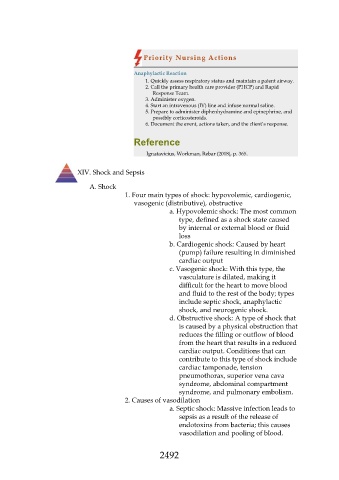Page 2492 - Saunders Comprehensive Review For NCLEX-RN
P. 2492
Priority Nursing Actions
Anaphylactic Reaction
1. Quickly assess respiratory status and maintain a patent airway.
2. Call the primary health care provider (PHCP) and Rapid
Response Team.
3. Administer oxygen.
4. Start an intravenous (IV) line and infuse normal saline.
5. Prepare to administer diphenhydramine and epinephrine, and
possibly corticosteroids.
6. Document the event, actions taken, and the client’s response.
Reference
Ignatavicius, Workman, Rebar (2018), p. 365.
XIV. Shock and Sepsis
A. Shock
1. Four main types of shock: hypovolemic, cardiogenic,
vasogenic (distributive), obstructive
a. Hypovolemic shock: The most common
type, defined as a shock state caused
by internal or external blood or fluid
loss
b. Cardiogenic shock: Caused by heart
(pump) failure resulting in diminished
cardiac output
c. Vasogenic shock: With this type, the
vasculature is dilated, making it
difficult for the heart to move blood
and fluid to the rest of the body; types
include septic shock, anaphylactic
shock, and neurogenic shock.
d. Obstructive shock: A type of shock that
is caused by a physical obstruction that
reduces the filling or outflow of blood
from the heart that results in a reduced
cardiac output. Conditions that can
contribute to this type of shock include
cardiac tamponade, tension
pneumothorax, superior vena cava
syndrome, abdominal compartment
syndrome, and pulmonary embolism.
2. Causes of vasodilation
a. Septic shock: Massive infection leads to
sepsis as a result of the release of
endotoxins from bacteria; this causes
vasodilation and pooling of blood.
2492

